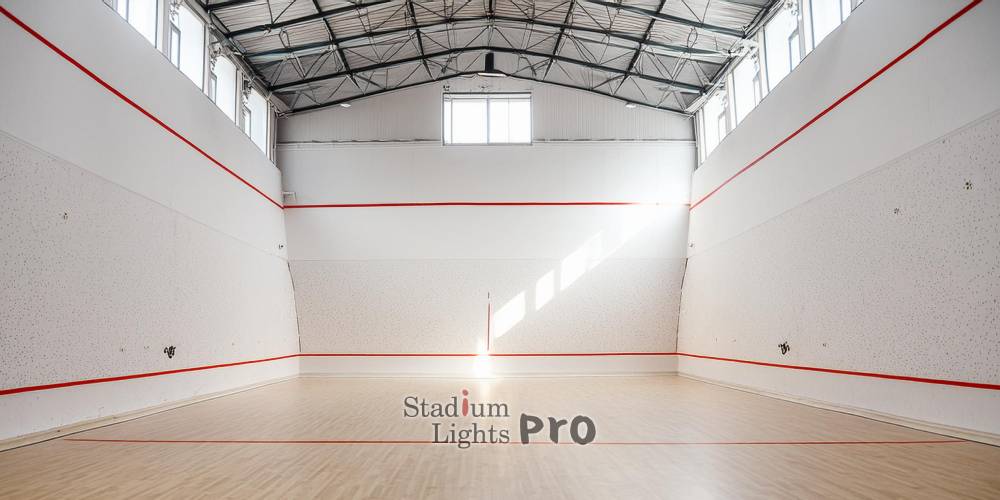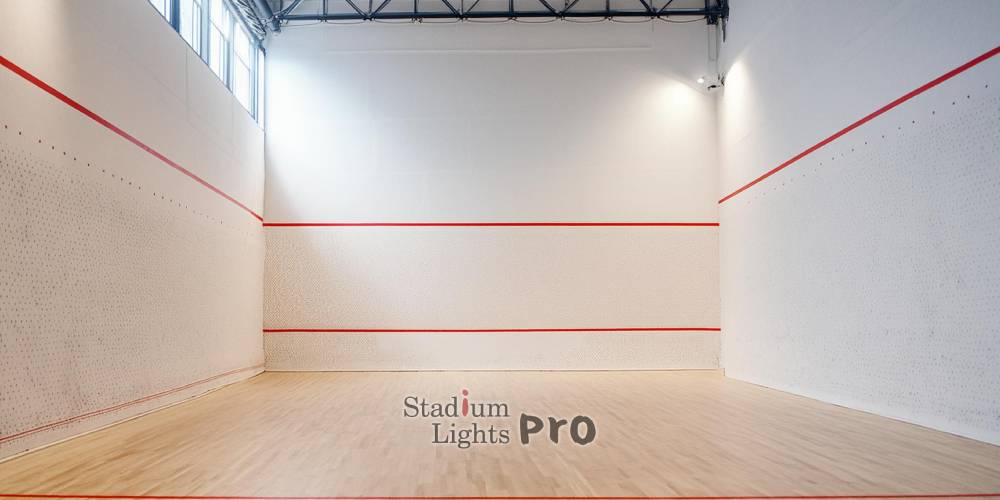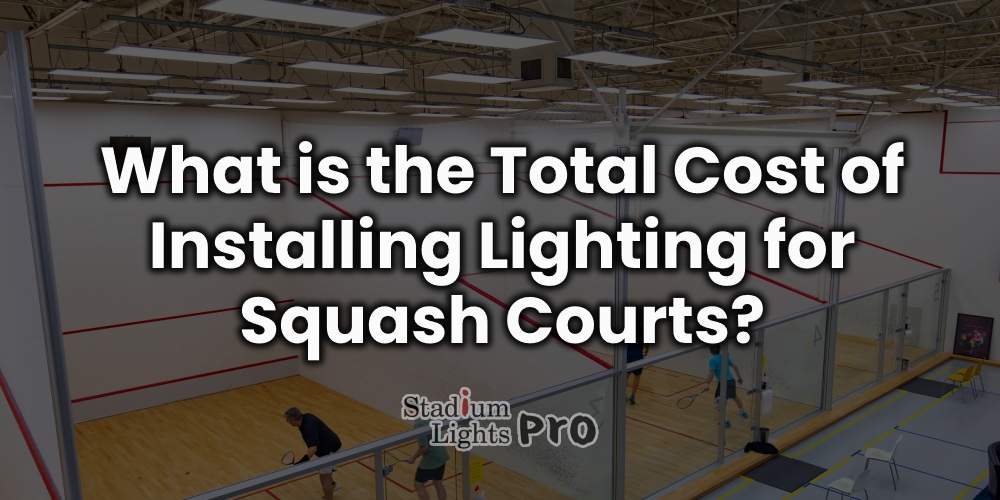LED technology offers superior brightness, energy efficiency, and longevity compared to traditional lighting options, making it an increasingly popular choice for sports facilities. By exploring the total cost of LED installations, including initial setup expenses and long-term operational savings, we aim to provide comprehensive insights into the economic and practical benefits of upgrading squash court lighting systems to LED.

Table of Contents
ToggleUnderstanding LED Lighting
Explanation of LED technology and its benefits
LED technology represents a significant advancement in lighting solutions, offering numerous benefits over traditional options. LEDs, or Light-Emitting Diodes, function by converting electrical energy into light through a semiconductor material. Unlike incandescent or fluorescent bulbs, LEDs produce minimal heat, making them more energy-efficient and durable. Additionally, LED lights have a longer lifespan, reducing maintenance and replacement costs. They also provide instant illumination without the need for warm-up time, making them ideal for sports environments like squash courts where quick and consistent lighting is essential. Furthermore, LEDs offer superior brightness and color rendering, enhancing visibility and ensuring optimal playing conditions for athletes. Overall, the adoption of LED technology promises not only improved performance but also significant cost savings and environmental benefits.
Comparison with traditional lighting options
When comparing LED lighting with traditional options such as fluorescent and incandescent bulbs, several key differences emerge. Firstly, in terms of energy efficiency, LED lights outperform both fluorescent and incandescent bulbs by consuming significantly less electricity to produce the same amount of light. This translates to lower energy bills and reduced environmental impact. Secondly, LED lights have a much longer lifespan compared to fluorescent and incandescent bulbs, which require frequent replacements. This not only reduces maintenance costs but also minimizes downtime for facilities such as squash courts. Moreover, LEDs emit light directionally, allowing for better control and distribution, whereas traditional bulbs emit light in all directions, leading to wasted light and energy. Moreover, LED lights contain no hazardous materials such as mercury, unlike fluorescent bulbs, making them safer for both the environment and human health. Overall, the comparison highlights the clear advantages of LED lighting in terms of energy efficiency, longevity, safety, and performance, making them the preferred choice for modern squash court installations.
Specific advantages of LED lights for squash courts
LED lights offer several tailored advantages for squash courts, beginning with their ability to provide consistent illumination across the court, ensuring players have optimal visibility without shadows or dark spots. Their instant on/off feature enables seamless gameplay transitions, while customizable lighting levels allow for adjustments to suit player preferences and specific game requirements. LED lights also excel in reducing glare, enhancing visual comfort and concentration during matches. Moreover, their energy efficiency not only lowers electricity costs but also reduces the carbon footprint of the facility. With a longer lifespan and durability, LED lights minimize maintenance requirements, ensuring reliable performance over extended periods. Besides, their superior color rendering accurately represents court colors and enhances the overall playing experience. These combined benefits make LED lights the preferred lighting choice for squash courts, offering optimal conditions for players while promoting sustainability and cost-effectiveness for facility operators.
| Item | Description | Price Range (USD) |
|---|---|---|
| LED High Bay Light Fixtures | High-output LED fixtures specifically designed for squash courts, providing uniform illumination and high energy efficiency. Suitable for ceiling mounting. Includes mounting brackets and hardware. | $250 – $600 per fixture |
| LED Wall-Mounted Fixtures | LED fixtures designed for wall mounting to supplement overhead lighting and ensure consistent illumination across the court. Provides additional brightness and reduces shadows. Includes mounting hardware. | $150 – $400 per fixture |
| LED Floodlights | Optional LED floodlights for outdoor courts or additional lighting requirements. Provides broad-spectrum illumination and weather-resistant design. Includes mounting brackets. | $100 – $300 per fixture |
| Labor Costs | Professional installation by licensed electricians or technicians, including wiring, mounting, and configuration of fixtures. Cost may vary based on the complexity of the installation and location. | $800 – $2000 (per court) |
| Wiring & Accessories | Electrical wiring, connectors, junction boxes, conduit, and other accessories required for proper installation and connection of LED fixtures. Additional materials may be needed depending on court layout and requirements. | $200 – $500 (per court) |
| Control Systems | Optional lighting control systems for dimming, scheduling, and remote management of LED fixtures. Enhances energy efficiency and allows for customization of lighting levels. Prices vary based on features and complexity. | $500 – $1500 (per court) |
| Total | $2,000 – $6,800 (per court) |
Factors Affecting Total Cost
Initial installation costs
The initial installation costs of LED lighting for squash courts encompass several key factors. Firstly, there’s the expense of purchasing the LED light fixtures themselves, which can vary depending on the brand, quality, and specific features required for the court’s dimensions and lighting requirements. Labor costs for professional installation must be considered, as skilled electricians or technicians may be needed to properly install and wire the lighting system. Furthermore, there may be additional expenses for materials such as wiring, mounting hardware, and any necessary accessories to ensure the lights are securely and safely installed. Overall, factoring in these components provides a comprehensive understanding of the initial investment required for transitioning to LED lighting in squash courts.
Cost of LED light fixtures
The cost of LED light fixtures is a significant component to consider when budgeting for squash court lighting. LED fixtures come in various styles and specifications tailored to different court sizes and lighting requirements. Factors influencing the cost include the brand, quality, luminosity, and specific features such as dimmability or adjustable color temperature. Higher-quality fixtures may command a higher price upfront but can offer better performance, durability, and energy efficiency, leading to long-term cost savings. The quantity of fixtures needed to adequately illuminate the court will impact the overall cost. Therefore, accurately assessing the cost of LED light fixtures is crucial for planning and budgeting the installation of lighting systems in squash courts.
Labor costs for installation
Labor costs for installation are a significant aspect to consider when budgeting for LED lighting installation in squash courts. Professional electricians or technicians typically handle the installation process, ensuring that the fixtures are properly mounted, wired, and configured for optimal performance. The labor costs can vary depending on factors such as the complexity of the installation, the number of fixtures being installed, and any additional customization or wiring requirements. It’s essential to budget adequately for labor costs to ensure that the installation is carried out safely and efficiently, ultimately contributing to the successful implementation of LED lighting in squash courts.
Additional materials
In addition to LED light fixtures and labor costs, there are various additional materials required for the installation of LED lighting in squash courts. Wiring is a crucial component, ensuring that the fixtures are properly connected to the electrical system and function reliably. Depending on the layout of the court and the positioning of the fixtures, additional wiring may be necessary to ensure uniform illumination. Mounting hardware such as brackets or supports may also be required to securely install the fixtures onto walls or ceilings. Furthermore, other miscellaneous materials such as junction boxes, connectors, and fasteners may be needed to complete the installation process. Considering these additional materials is essential for accurately estimating the total cost of transitioning to LED lighting in squash courts.
Operational costs
Operational costs encompass ongoing expenses associated with the use and maintenance of LED lighting in squash courts. These costs primarily include electricity consumption for powering the LED fixtures. However, due to the energy efficiency of LEDs, operational costs are typically lower compared to traditional lighting options. Moreover, maintenance costs are reduced thanks to the longer lifespan of LED lights, which require less frequent replacement and upkeep. While LED fixtures may have a higher upfront cost, the lower operational and maintenance costs over time result in significant savings for squash court operators. Therefore, accurately assessing operational costs is crucial for understanding the long-term economic benefits of transitioning to LED lighting in squash courts.
Energy efficiency of LED lights
The energy efficiency of LED lights is one of their most notable advantages, making them an attractive option for squash court lighting. Unlike traditional lighting options such as incandescent or fluorescent bulbs, which waste a significant amount of energy as heat, LED lights convert a higher percentage of electricity into visible light. This results in reduced energy consumption and lower electricity bills for squash court operators. LED lights also have the ability to produce the same amount of light as traditional bulbs while using significantly less power, making them an environmentally friendly choice. Additionally, LED technology allows for precise control over light output, enabling squash court operators to adjust lighting levels as needed to optimize energy usage without compromising visibility or player safety. Overall, the energy efficiency of LED lights not only reduces operational costs but also contributes to sustainability efforts by conserving energy resources.
Longevity and maintenance requirements
The longevity and maintenance requirements of LED lights are significant factors that contribute to their appeal for squash court lighting. LED lights have an exceptionally long lifespan compared to traditional lighting options, typically lasting tens of thousands of hours before needing replacement. This extended lifespan reduces the frequency of bulb changes, resulting in lower maintenance costs and less downtime for the squash court. LED lights are more durable and resistant to shock and vibration, making them less prone to damage during use. With minimal maintenance requirements and a long-lasting performance, LED lights offer squash court operators a reliable and cost-effective lighting solution that enhances the playing experience for athletes and ensures optimal visibility on the court.
Potential savings over time compared to traditional lighting options
The potential savings over time compared to traditional lighting options are substantial when considering the transition to LED lighting for squash courts. While LED fixtures may have a higher initial investment, their energy efficiency and longevity result in significant cost savings over the long term. LED lights consume less electricity to produce the same amount of light as traditional bulbs, leading to lower energy bills for squash court operators. In addition, the extended lifespan of LED lights reduces the need for frequent bulb replacements, saving on maintenance costs and labor expenses. Furthermore, the superior durability and reliability of LED fixtures minimize downtime and disruptions to court activities. Overall, the cumulative savings from reduced energy consumption, maintenance, and operational costs make LED lighting a financially prudent choice for squash courts, offering a compelling return on investment over time.

Cost Analysis
Comparison between LED and traditional lighting costs
A comparison between LED and traditional lighting costs highlights the economic advantages of transitioning to LED lighting for squash courts. While LED fixtures typically have a higher upfront cost, they offer significant long-term savings due to their energy efficiency and longevity. LED lights consume less electricity to produce the same amount of light as traditional bulbs, resulting in lower energy bills over time. Moreover, LED fixtures have a much longer lifespan and require less frequent replacement compared to traditional bulbs, reducing maintenance and labor expenses. When considering the total cost of ownership, including initial investment, energy consumption, and maintenance, LED lighting emerges as the more cost-effective option for squash courts. Despite the higher upfront cost, the overall savings and benefits of LED lighting make it a wise investment for squash court operators seeking to optimize efficiency and reduce operational expenses in the long run.
Consideration of long-term savings and return on investment
Considering long-term savings and return on investment (ROI) is crucial when evaluating the transition to LED lighting for squash courts. While LED fixtures may entail a higher initial investment compared to traditional lighting options, their energy efficiency and longevity result in significant cost savings over time. By consuming less electricity and requiring fewer replacements, LED lights reduce ongoing operational and maintenance expenses for squash court operators. Additionally, the extended lifespan of LED fixtures minimizes downtime and disruptions to court activities, further enhancing the overall ROI. When assessing the total cost of ownership and factoring in energy savings, reduced maintenance costs, and improved performance, the ROI of LED lighting becomes apparent, offering squash court operators a compelling financial incentive to make the switch. By prioritizing long-term savings and ROI considerations, squash court operators can make informed decisions that not only optimize efficiency and performance but also contribute to financial sustainability in the years to come.
Additional Considerations
Importance of choosing the right lighting design for squash courts
The importance of choosing the right lighting design for squash courts cannot be overstated, as it directly impacts the playing experience, safety, and overall atmosphere of the facility. Proper lighting design ensures optimal visibility on the court, allowing players to track the ball accurately and react swiftly during gameplay. The right lighting design enhances safety by minimizing the risk of accidents and injuries, such as collisions or missteps due to poor visibility. Moreover, the lighting design contributes to the overall ambiance and aesthetics of the squash court, creating an inviting and professional environment for players and spectators alike. Factors to consider when designing squash court lighting include the placement and orientation of fixtures, the intensity and uniformity of illumination, and the control of glare and shadows. By prioritizing the selection of the right lighting design, squash court operators can create a conducive and enjoyable environment for players while ensuring optimal performance and safety standards are met.
Environmental impact and sustainability of LED lighting
The environmental impact and sustainability of LED lighting make it a compelling choice for squash courts and other facilities. LED lights are highly energy-efficient, consuming significantly less electricity than traditional lighting options such as incandescent or fluorescent bulbs. This reduced energy consumption translates to lower greenhouse gas emissions and less strain on energy resources, contributing to environmental conservation efforts and mitigating climate change. Additionally, LED lights contain no hazardous materials such as mercury, unlike fluorescent bulbs, making them safer for both human health and the environment. Furthermore, the long lifespan of LED fixtures reduces the frequency of replacements, minimizing waste and resource consumption associated with manufacturing and disposal. Overall, the adoption of LED lighting promotes sustainability by reducing energy consumption, minimizing environmental impact, and conserving resources, making it a responsible choice for squash courts and other sports facilities.
Potential rebates or incentives for energy-efficient lighting installations
There are potential rebates or incentives available for energy-efficient lighting installations, including LED lighting upgrades in squash courts. Many utility companies and government agencies offer financial incentives to encourage businesses and organizations to adopt energy-efficient technologies and reduce their carbon footprint. These incentives may include cash rebates, tax credits, or grants that help offset the upfront costs of purchasing and installing LED lighting fixtures. Furthermore, some programs offer incentives for conducting energy audits or implementing other energy-saving measures in conjunction with lighting upgrades. By taking advantage of these rebates and incentives, squash court operators can lower their initial investment in LED lighting and accelerate the return on investment while contributing to environmental sustainability efforts. It’s advisable to research and consult with local utility providers or energy efficiency programs to explore available incentives and maximize cost savings for lighting installations.
Conclusion
The transition to LED lighting in squash courts offers numerous benefits, ranging from improved visibility and safety to cost savings and environmental sustainability. By providing consistent illumination, reducing energy consumption, and minimizing maintenance requirements, LED lighting enhances the overall playing experience while promoting financial efficiency and environmental responsibility. Considering factors such as initial installation costs, operational expenses, and long-term savings highlights the economic advantages of LED lighting over traditional options. Furthermore, incentives and rebates available for energy-efficient lighting installations further incentivize the adoption of LED technology, making it a viable and attractive choice for squash court operators. Ultimately, prioritizing the selection of the right lighting design ensures optimal performance, safety, and ambiance, creating an inviting and professional environment for players and spectators alike. With its combination of practical benefits and sustainable features, LED lighting emerges as a strategic investment for squash courts, aligning with both economic and environmental goals for years to come.

